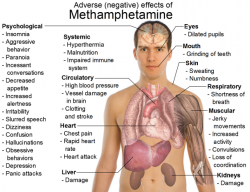Long Term Meth Effects
Meth, also known as crystal meth or methamphetamine, belongs to the stimulant class of narcotic substances. As far as stimulant-type drugs go, meth produces the most powerful effects even when compared to cocaine. Likewise, long term meth effects can cause considerably more damage to brain and body functions than cocaine.
According to the National Institute on Drug Abuse, in 2012, an estimated 12 million Americans reported trying meth at least once in their lifetime. As far as emergency room visits go, meth use ranks fourth as the most common drug-related cause.
As meth’s damaging effects can develop within a short period of time, long term meth effects stand to greatly impair a person’s physical and psychological health over time.
Meth Effects

Crystal meth causes significant long-term damage to a person on many levels, but recovery is possible!
As a stimulant drug, meth exerts its greatest effects within the body’s central nervous system. Likewise, the “high” produced by meth results from the massive amounts of neurotransmitter chemicals that flood the body’s central nervous system.
Meth causes most every bodily function to work faster and harder for hours at a time. After a while, the ongoing overstimulation of brain chemical processes leaves the body in a continual state of “burn out.” In actuality, long term meth effects of meth can start to take shape within a relatively short period of continuous use.
“Tweaking”
Someone who uses meth on a frequent basis will start to develop a tolerance to the drug’s effects. In fact, the brain’s tolerance for meth effects rises quickly driving users to consume increasingly larger doses.
“Tweaking” involves ingesting multiple doses of meth at a time. After a while, users engage in tweaking behaviors in order to compensate for rapidly rising tolerance levels. According to the University of Maryland, tweaking practices can cause a person to go for days without sleeping.
Health Problems
Over time, meth effects cause extensive damage throughout the body, affecting most every major bodily system. Long-term meth users will start to take on an unhealthy appearance as poor dietary habits compromise essential immune system functions.
Health problems may take the form of:
- Drastic weight loss
- Bags under the eyes
- Sores along skin surfaces
- Sallow complexion
- Heart attack risks
- Stroke risks
- Constipation
Psychotic Behavior Displays
Before long, meth effects on the brain start to impair a person’s overall cognitive functions making it difficult for him or her carry out everyday tasks and responsibilities. With continued use, significant brain chemical imbalances form. These conditions can only but compromise a person’s emotional stability.
With long-term use, psychotic-like behavior displays become commonplace, some of which include:
- Frequent mood swings
- Violent outbursts
- Hallucinations
- Paranoia
Continued meth use will likely result in permanent damage as brain structures continue to deteriorate.
Addiction
Considering how quickly the brain and body become physically dependent on meth effects, a person will soon start to see signs of addiction with ongoing drug use. Once addicted, addicts come to depend on meth to get them through the day. In effect, a person’s entire mindset has been altered to the point where everything that’s good in life begins and ends with meth’s “high” effects.



